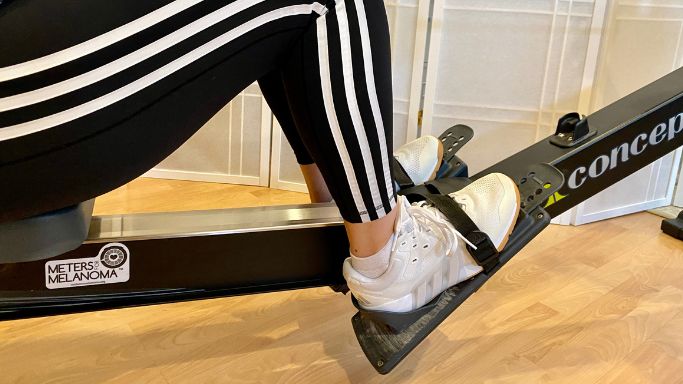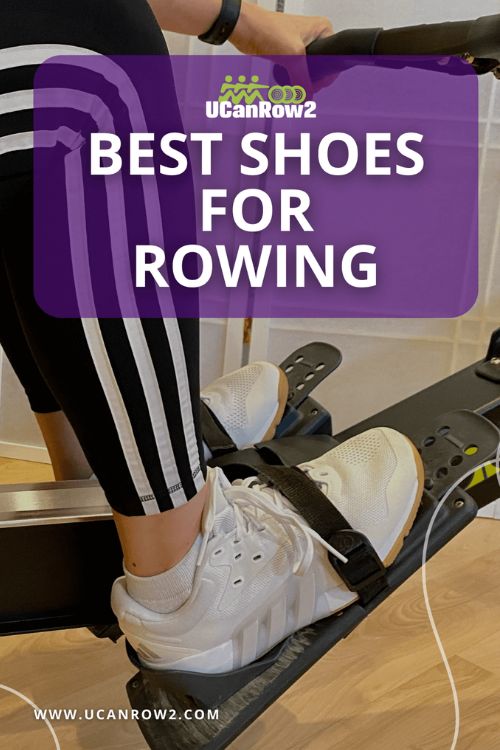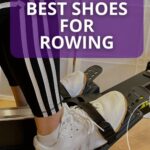Step Up Your Indoor Rowing Game With the Right Shoes For Rowing
Have you ever wondered how much difference a pair of shoes can make in your indoor rowing workout? Well, you might be surprised!
If you’ve ever found yourself powering through a rowing workout, only to be distracted by discomfort in your feet or feeling like your results are less than they should be, it might just be your rowing shoes that are the culprit.
Indoor rowing is an amazing, total-body workout that many of us have come to love. It’s like having a secret weapon against aging that burns calories, boosts cardiovascular health, and works nearly every muscle on every stroke.
All without putting undue stress on your joints.
But, just like any other activity, having the right gear to do it makes ALL the difference in both our enjoyment and our results – and that’s where proper shoes for rowing come in.
In this post, we’re going to dive into what makes good shoes for the rowing machine.
We’ll talk about why they matter, what to look for, and how to find the perfect pair for your needs.
Investing in the right pair of rowing shoes isn’t just about comfort (although that’s certainly important too!). It’s about helping you row better, feel better, and get the most out of every workout.
So let’s jump in, shall we?
Factors To Consider When Choosing Shoes for the Rowing Machine
It’s always best to get the right shoe for the activity where possible.
In the case of rowing, that means a shoe that offers a combination of comfort, stability, flexibility, and a heel height that allows for efficient and effective power transfer.
Here are some things to think about:
✅ Comfort: Indoor rowing is a repetitive motion, and you’ll take LOTS of strokes in a standard workout. Wearing shoes for rowing that fit and move comfortably can help you keep the focus on your rowing technique, and off any blisters or foot injuries.
✅ Heel height: The best shoes for the rowing machine have flat soles that aren’t super thick. Running shoes, with their typical big cushion and noticeable drop from the heel to the toe, aren’t a great choice. That’s because that angle changes your foot placement at the catch, which can limit your ability to transfer power efficiently.
✅ Flexibility: Shoes for rowing need to be flexible so your feet can move through the full range of motion. That includes lifting your heels at the catch as needed to get your shins to come to a vertical position. So stiff shoes like lifters aren’t the best choice.
✅ Stability: Your foot and foot placement are an essential part of the rowing stroke. It’s there that you transfer force from your feet to the machine and generate power! If your rowing shoes don’t give you enough grip or allow you to push with your whole foot, you could end up with a less powerful stroke.
✅ Breathability: Your feet sweat just like the rest of you when you work out. Shoes made of breathable materials can help to dissipate that heat, thereby making you more comfortable, and less prone to developing blisters on long rows.
If you caught the photo up top, these are the ones I’ve been loving lately for my own rowing workouts and they’re a great example of what to look for.
They’re the Dropset from adidas. Note the low, flat sole (Which also happens to be nice for the lifting I often do off the rowing machine!) and the wide toe box that fits my big flippers nicely.
Pull that rowing machine strap tight across the widest part of your foot, roughly the tops of the shoelaces on a shoe like this, and you’re good to go!
What to Look for in How Your Rowing Shoes Fit
When trying on shoes for rowing, look for something that holds your foot comfortably and doesn’t allow it to slide around.
Running shoes, for example, are typically designed to have a bit of extra space in the toe box since feet can swell and move forward during a run.
In rowing shoes though, a slightly snugger fit is generally preferable to keep your feet from moving around too much during the stroke.
Keep in mind, though, if you’re going to be getting on and off the machine for your workout you also want to consider what else you’re doing in your workout. Pick the shoe that works for what you’re going to be doing for the majority of your workout.
When to Get New Shoes for Rowing
If you’re a person who only uses their rowing shoes for rowing, yours should last a good long time.
If, however, your typical workout involves rowing and then getting off the machine to do other activities, you’ll likely have fewer days of good wear from them.
According to the American Academy of Podiatric Sports Medicine, your shoes should be replaced after 300-500 miles of running or walking, or 45-60 hours of activities like basketball or tennis.
Depending on what you’re doing off the rowing machine, your shoes should last longer than that since rowing is no- to low-impact. But the shoe will still break down over time regardless and can potentially lead to overuse injuries.
Check the AAPSM page for some helpful information on how to look at how your shoes are sitting to see if it’s time to hit the shoe store.
Also, keep an eye on how you feel. If you have aches and pains developing in your feet, knees, or ankles that you didn’t have before, for example, your shoes may well be the culprit.
In both cases, you’ll get more use out of your rowing shoes if you:
- Let them air out and dry in between uses, and
- Save them for use during your rowing workouts and not for other purposes
What About Rowing Barefoot?
Not everyone will agree on this one, but I think you should have your feet covered any time you’re on the rowing machine, and preferably covered by shoes and not just socks.
Yes, you want to be able to feel your foot in contact with the footplates when you row, but I’ve never found the heel cup remotely comfortable on a bare or stocking foot (regardless of the brand of machine).
If the plastic heel cup rubs your foot raw, as it very well might on a longer row, then you’ve got an open sore that can easily get aggravated.
And rowing in bare feet on shared fitness equipment is just gross.
That being said, if you have your own machine and barefoot works for you, go for it.
So What’s The Go-To Rowing Shoe?
Ask 10 rowers what shoes they wear to work out and you’ll get 10 different answers. The great news is there are loads of options out there.
Follow the basic template of a shoe with:
- A flat sole
- More flexible than stiff
- Somewhat snug fit
And you’ll be off to the (rowing) races!
Final Thoughts
Overall, the right shoes can significantly enhance your indoor rowing workout experience. They can improve your performance, help keep you injury-free, and keep you more comfortable throughout your workout.
So, it’s worth investing the time and effort to find the right pair!
Wherever you land in terms of shoe and fit, you’ll get more life out of your rowing shoes if you:
- Let them air out and dry in between uses, and
- Save them for use during your rowing workouts and not for other purposes
Got thoughts, recommendations, or a question about shoes for rowing? Let us know in the comments!





I have found the Rogue Crossfit (Ballistic line) shoe is ideal. Flat bottom slim profile not a whole lot of cushion but enough to be comfortable. Perfect for the job
Thanks Allen, I’m going to check those out! You can never have enough good shoes for rowing!
Converse All Star Chuck Taylor low tops. Canvas. Flat. Perfect. Can get them literally anywhere that sells shoes. And great colors too!